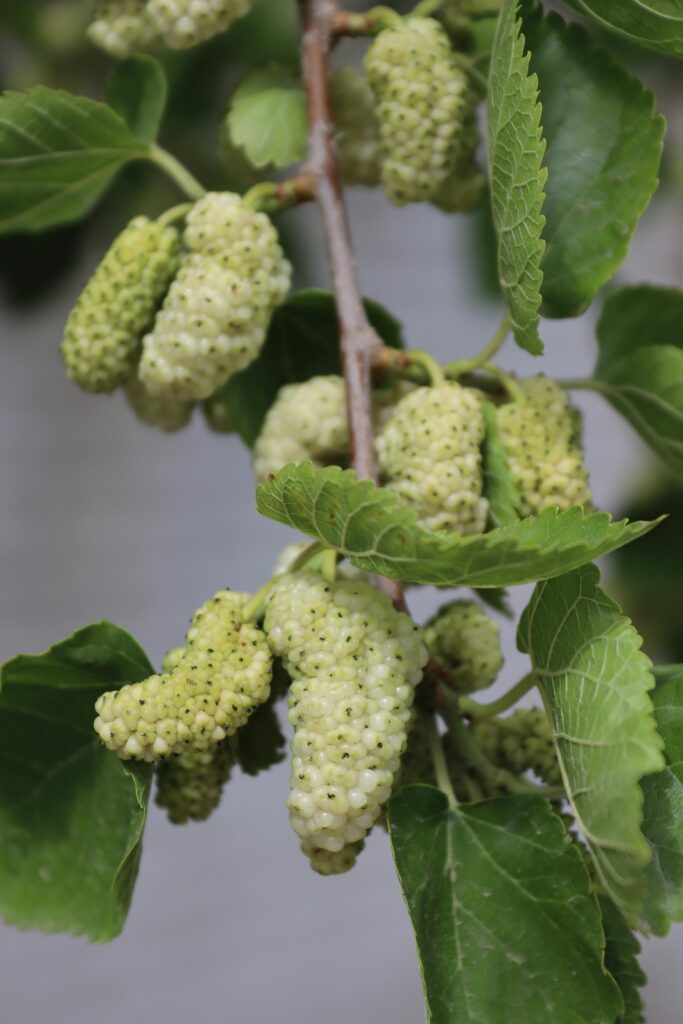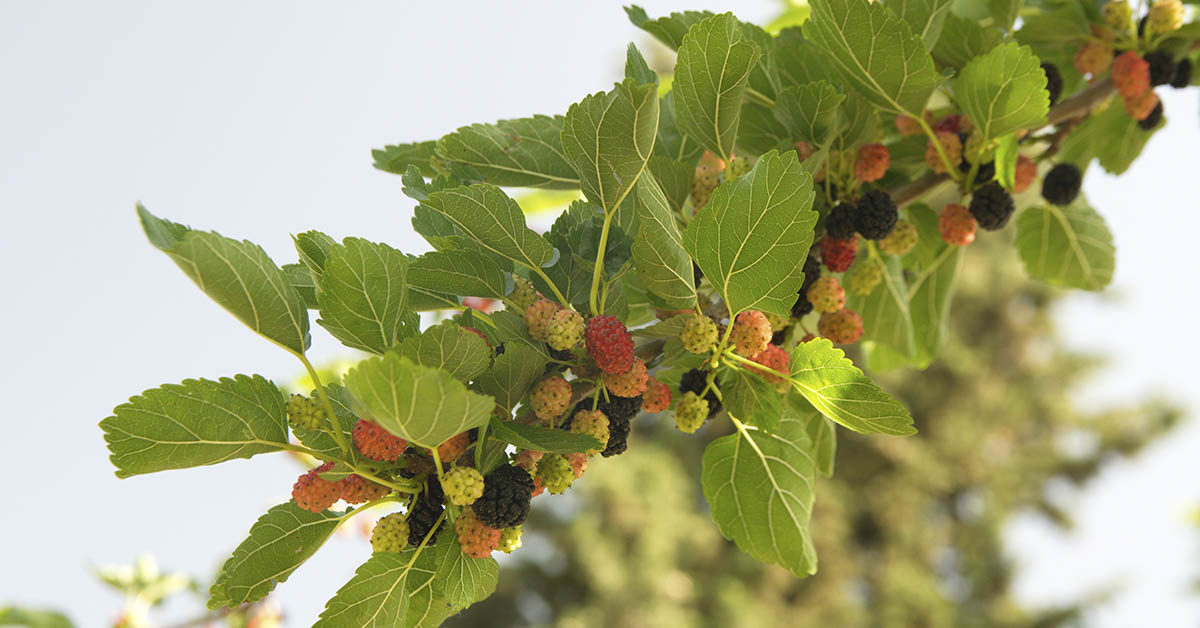As rates of high blood pressure and diabetes continue to rise, so does interest in natural remedies that may help manage these conditions. One everyday plant is gaining attention for its potential to support better health: the White Mulberry tree.
Not only do they produce delicious fruit, but their bark and leaves also hold potent natural benefits. Recent research highlights the many ways White Mulberry plants may support everyday health, particularly by enhancing metabolic functions.
White Mulberry and Its Ancient History

White Mulberry (Morus alba) is a tree species native to India and China and has been used for centuries in both Traditional Chinese Medicine and Ayurveda.
- In Chinese medicine, it has been used to reduce fever, soothe sore throats, calm coughs, relieve dizziness, and cool the liver.
- In Ayurvedic practice, White Mulberry is valued for its cooling properties and is commonly used to support healthy digestion, improve blood circulation, and relieve constipation.
Beyond its medicinal uses, White Mulberry plants have played a vital role in agriculture and industry. Craftsmen once used their strong, durable wood to make tools and equipment, while silk producers fed their leaves to silkworms, relying on them as the primary food source for silk production
Today, this ancient plant is gaining renewed interest in modern wellness circles for its wide range of potential health benefits.
Nutritional Profile of White Mulberries
One cup (140 grams) of raw white mulberries contains:
- 60 calories
- 14 g of carbohydrates
- 2 g of protein
- 1 g of fat
- 2 g of fiber
Key Nutrients and Compounds:
- Vitamins: C (51 mg), A, K, E
- Minerals: Iron (3 mg), calcium (55mg), potassium (272mg), magnesium (25mg)
- Antioxidants: Flavonoids, resveratrol, chlorogenic acid
- Bioactive Compounds:
- 1-Deoxynojirimycin (DNJ): A plant alkaloid, found mainly in mulberry leaves, known for inhibiting carbohydrate-digesting enzymes
- Quercetin & Rutin: Flavonoids with anti-inflammatory and antioxidant properties
- Resveratrol: A compound known for its potential benefits in preventing heart disease and extending lifespan.
1. Blood Sugar Regulation
DNJ, found in mulberry leaves, inhibits alpha-glucosidase, an enzyme responsible for breaking down carbohydrates, thereby slowing sugar absorption and stabilizing blood glucose levels after meals.
- A 2016 double-blind, placebo-controlled study found that mulberry leaf extract significantly reduced blood sugar spikes and insulin levels over a 2-hour period after sugar consumption.
- Another small study in individuals with type 2 diabetes showed that taking 1,000 mg of mulberry leaf extract three times daily for three months significantly lowered post-meal blood glucose levels.
2. Heart Health & Cholesterol

Mulberry leaf extract may support cardiovascular health by reducing “bad” LDL cholesterol and triglycerides while increasing “good” HDL cholesterol.
- In animal studies, mulberry leaf tea and extract lowered total cholesterol, LDL cholesterol, and triglycerides in mice and rats on high-fat diets.
- In another animal study, mulberry leaf extract helped lower cholesterol, triglycerides, and LDL cholesterol. It also reduced plaque in the arteries, stopped the growth of unwanted blood vessel cells, and improved blood vessel function. Its natural compounds, polyphenols and flavonoids, produce these benefits.
Though these results show promise, researchers need to conduct more human studies to confirm efficacy and determine proper dosage.
3. Weight Management
White mulberry may support weight loss by slowing carbohydrate absorption, regulating appetite, and enhancing fat metabolism.
- In a study involving 46 overweight individuals, those who took 2,400 mg of Japanese white mulberry extract daily while following a 1,300-calorie diet lost approximately 9 kilograms (about 20 pounds) over 3 months.
4. Antioxidant & Anti-Inflammatory Effects
Mulberry leaves are rich in antioxidant compounds that help neutralize oxidative stress, a key factor in aging and chronic disease.
- Mulberry leaves contain abundant phenolic compounds and flavonoids that have strong antioxidant effects. These compounds efficiently scavenge free radicals and reduce oxidative stress, which contributes to cellular aging and chronic diseases.
- In cell culture models, mulberry leaf extracts inhibit the production of nitric oxide (NO) and reduce harmful enzymes and proteins that cause inflammation (like iNOS and COX-2). By lowering these inflammatory substances, the extracts help protect cells from damage.
- Animal studies have demonstrated that mulberry leaf extracts can significantly decrease inflammation and restore various blood parameters toward normal levels.
Cell and animal studies have demonstrated anti-inflammatory properties, suggesting that White Mulberry may protect against cellular damage and inflammation.
5. Potential Immune System Support
In laboratory and animal studies, mulberry extracts have been shown to influence the immune system by activating macrophages, cells that remove harmful bacteria and dead cells, and by increasing the production of cytokines such as TNF-α, IL-6, and IL-12. These proteins help immune cells communicate and coordinate responses. Compounds in white mulberry have also been found to support the development of dendritic cells, which detect pathogens and help activate other immune cells. These effects may, in turn, influence the function of T cells, which attack infected or damaged cells, and B cells, which produce antibodies.
In vitro studies have reported that white mulberry fruit extracts inhibit the growth of certain bacteria, including Staphylococcus aureus, suggesting possible antibacterial properties.
While these findings are promising, they are based primarily on preclinical models. More human studies are needed to determine whether these immune-related effects occur in people and under what conditions.
Traditional & Modern Applications
In both ancient and modern times, White Mulberry has been used to support health in various forms. Today, many forms are available for the general public, including:
- Teas
- Capsules
- Powders
- Standardized extracts
Dosage, Safety, and Considerations

Clinical studies and supplement manufacturers often recommend a daily dose of 1,000 to 3,000 mg. White mulberry is generally safe for short-term use, though some people may experience mild side effects like bloating, gas, or loose stools. Researchers have not yet gathered enough data on its long-term safety.
Final Thoughts
The White Mulberry tree is more than just a fruit-bearing plant, it’s a source of potent bioactive compounds and nutrients with wide-ranging health benefits. From blood sugar, cholesterol and immune support, emerging research supports its value in promoting metabolic and overall health.
While more human research is needed, White Mulberry shows real promise as a natural complement to a health-conscious lifestyle. As always, speak with your healthcare provider before adding new supplements to your routine.
Disclaimer: This information is not intended to be a substitute for professional medical advice, diagnosis or treatment and is for information only. Always seek the advice of your physician or another qualified health provider with any questions about your medical condition and/or current medication. Do not disregard professional medical advice or delay seeking advice or treatment because of something you have read here.
Read More: Ten Science-Backed Herbs and Supplements to Help Lower Your Blood Sugar Naturally

